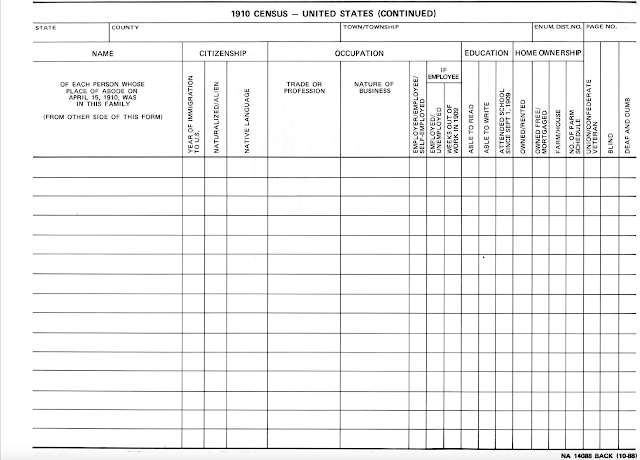 |
| https://www.archives.gov/files/research/genealogy/charts-forms/1910-census.pdf |
The 1910 U.S. Federal Census was on one page, even though the readable form shows two separate pages. The 1910 Census also had questions direct at American Indians (Native Americans). Here are the questions asked including those directed at the Indians.
- Number of dwelling house in order of enumeration
- Number of family in order of enumeration
- Name
- Relationship to head of the family
- Sex
- Color or Race: Enumerators were to enter "W" for White, "B" for Black, "Mu" for mulatto, "Ch" for Chinese, "Jp" for Japanese, "In" for American Indian, or "Ot" for other races.
- Age
- Is the person single, married, widowed, or divorced? Enumerators were to enter "S" for single, "Wd" for widowed, "D" for divorced, "M1" for married persons in their first marriage, and "M2" for those married persons in their second or subsequent marriage.
- Number of years of present marriage
- How many children is the person the mother of?
- Of the children a person has mothered, how many are still alive?
- Place of birth of the person
- Place of birth of the person's father
- Place of birth of the person's mother
- Year of immigration to the United States
- Is the person naturalized or an alien?
- Can the person speak English? If not, what language does the person speak?
- The person's trade, profession, or occupation
- General nature of the industry, business, or establishment in which this person works
- Is the person an employer, employee, or working on his own account?
- If the person is an employee, was he out of work on April 15, 1910?
- If the person is an employee, what is the number of weeks he was out of work in 1909?
- Can the person read?
- Can the person write?
- Has the person attended school at any time since September, 1909?
- Is the person's home owned or rented?
- Is the person's home owned free or mortgaged?
- Does the person reside in a home or on a farm?
- If on a farm, what is the farm's identification number on the census farm schedule?
- Is the person a survivor of the Union or Confederate Army or Navy?
- Is the person blind in both eyes?
- Is the person deaf and dumb?
- Tribe of this person
- Tribe of this person's father
- Tribe of this person's mother
- Proportion of this person's lineage that is American Indian
- Proportion of this person's lineage that is white
- Proportion of this person's lineage that is black
- Number of times married
- Is this person living in polygamy?
- If this person is living in polygamy, are his wives sisters?
- If this person graduated from an educational institution, which one?
- Is this person a taxed? An American Indian was considered "taxed" if he or she was detached from his or her tribe and was living in the white community and subject to general taxation, or had been allotted land by the federal government and thus acquired citizenship.
- If this person had received an allotment of land from the government, what was the year of that allotment?
- Is this person residing on his or her own land?
- Is this person living in a "civilized" or "aboriginal" dwelling? Enumerators were to mark "Civ." (for "civilized") if the person was living in a log, frame, brick, or stone house, etc. and "Abor." (for "aboriginal") if the person was living in a tent, tepee, cliff dwelling, etc.
A positive answer to question number 30 would suggest that further research should be done to locate military records and possible pension records. The questions about immigration and naturalization are valuable in helping researchers to find additional records such as naturalization documents and passenger lists.
It is also important to note any inconsistencies between the answers given in prior census years. Changes in ages and birth dates are common, but other changes may give clues to important information that may have been intentionally omitted in prior censuses.
Continued
Previous posts in this series.
http://genealogysstar.blogspot.com/2016/10/moving-beyond-census-records-part-seven.html
http://genealogysstar.blogspot.com/2016/10/moving-beyond-census-records-part-six.html
http://genealogysstar.blogspot.com/2016/10/moving-beyond-census-records-part-five.html
http://genealogysstar.blogspot.com/2016/10/moving-beyond-census-records-part-four.html
http://genealogysstar.blogspot.com/2016/10/moving-beyond-census-records-part-three.html
http://genealogysstar.blogspot.com/2016/10/moving-beyond-census-records-part-two.html
http://genealogysstar.blogspot.com/2016/09/moving-beyond-census-records-part-one.html





No comments:
Post a Comment